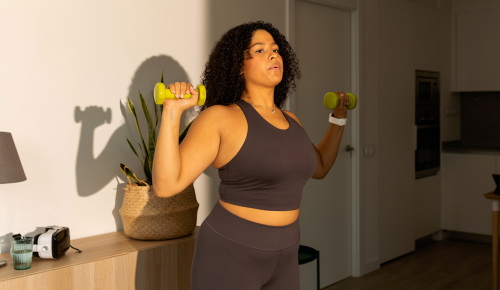Our editors independently select these products. Making a purchase through our links may earn Well+Good a commission
There are seasons in life when a 15-minute walk is the most you can commit to your exercise routine—and, hey, that’s 100 percent okay. Maybe your job is more of a nine-to-nine than a nine-to-five right now, or childcare is monopolizing your free moments.
Experts in This Article
a cardiologist at Manhattan Cardiology in New York City
New Jersey-based cardiologist
Whatever the case may be, we asked a cardiologist to answer the age-old question: Is walking a good exercise? And the first thing you need to know is that the simple answer is yes. But there’s more to it.
Keep reading to uncover the health benefits of walking, and what cardiologists think of the movement altogether.
The health benefits of walking
We’ll shout it from the rooftops: Walking is good for you! Even the smallest neighborhood loop—even just walking a mile a day—can have an immense impact on your health and well-being.
“Walking can definitely help reduce the risk of heart disease as well as other medical problems,” says cardiologist Karishma Patwa, MD, with Manhattan Cardiology in New York City. “Specifically, it helps the heart by improving oxygen flow throughout your body, lowering your blood pressure and cholesterol, and strengthening your heart and blood vessels.”
“The take-home point here is that even 15 minutes a day of walking, without stopping, provides benefit with regards to cardiovascular morbidity and mortality,” adds New Jersey-based cardiologist Michael Weinrauch, MD.
Morbidity refers to illness or disease, while mortality refers to death. Research has associated 15 minutes of activity with a 22 percent lower risk of death (mortality), and walking with a 43 percent reduced risk in stroke and a reduction in the risk factors of heart attack (morbidity), regardless of how fast your heart is beating.
“Keep in mind, most of the research that has been done on the benefits of walking have been done without monitoring heart rates during physical activity,” Dr. Weinrauch says. “Remember, the Fitbit and smartwatch apps are still actually a relatively new phenomenon.”
TL;DR: The morbidity and mortality benefits of walking seem to occur regardless of your heart’s beats per minute (BPMs).
“The take home point here is that even 15 minutes a day of walking, without stopping, provides benefit with regards to cardiovascular morbidity and mortality.” – Michael Weinrauch, MD
How to take your daily walk up a notch
Looking to reap even more rewards from walking? You can increase your cardiovascular fitness by increasing your heart rate and going longer distances—and that may offer even more benefits when it comes to morbidity and mortality, according to UC Davis Health. To help further guide you in your walking goals, check out the answers to the FAQ, below.
Is it better to walk faster or longer?
If you’re trying to decide whether to walk fast or walk far, both options are beneficial. “Incrementally adding distance and speed will help with your cardiovascular health,” Dr. Patwa says. “You can mix it up and do short fast walks on some days or longer more leisurely walks on others.”
How does incline affect results?
It amps up your heart rate, Dr. Patwa says. That’s why the 12-3-30 trend has become such a sensation. In just half an hour, you’re able to substantially strengthen your heart, enhance your cardio, and burn more calories as a result. Because of this, the the 12-3-30 workout—and walking on an incline in general—is said to boost weight loss efforts, per the Cleveland Clinic.
Is walking with ankle weights beneficial?
It can be! As we’ve previously reported, walking with ankle weights has its pros and cons. On one hand, adding ankle weights puts more weight on your frame, which causes your body to work harder to move, subsequently making you burn more calories in the process.
On the other, heavy ankle weights can overstrain your ankle joints which can potentially lead to injury. With this in mind, you should stick to weights of no more than a couple of pounds. Bala Bangles ($55) are a great (and chic) option. Best of all, you can use them on your wrists, too, which will allow you to incorporate arm exercises while walking.
What heart rate zones should you aim for?
Classes like Orangetheory Fitness popularized working out with your heart rate in mind. Now, newer models of the Apple Watch allow you to track your heart rate during cardio. This of course makes people wonder what heart rate zone is ideal when walking and working out in general.
“For an exercise to be considered cardio, it should [catapult] your heart rate and breathing rate into the moderate to vigorous intensity level (at least 50 percent of the normal rate) for a minimum of 10 minutes,” Dr. Patwa says.
According to Orangetheory Fitness, the five key heart rate zones are as follows:
- 1: Light activity; 50-60% max HR
- 2: Warm up; 61-70% max HR
- 3: Challenging but doable; 71-83% max HR
- 4: Uncomfortable (aka the “Orange Effect”); 84-91% max HR
- 5: All out; 92-100% max HR (When it comes to walking vs. running, heart rate zone 5 is reserved for running; you likely won’t hit the all-out zone while walking, unless going up a severe incline.)
While heart rate can guide you on your walking journey, Dr. Weinrauch says not to get too caught up in it.
“Cardiovascular fitness or aerobic fitness can be defined as a measurement of the body’s ability to deliver oxygen to its muscles,” he says. “VO2 max, which is the maximum rate that oxygen can be consumed during exercise that increases in intensity, is the gold standard for measurement of fitness.”
However, it’s really up to you how “fit” you want to be. If you’re someone who wants to build up your VO2 max soyou can train for a marathon, fantastic. And if you’re someone who’s content with a brisk walk to your favorite coffee store, that’s also great.
Can you get in shape solely by walking?
Walking works muscles from head to toe. While it’s an exercise that taps into your core, it’s not the ideal sole workout for folks looking to get cut. “Overall, aerobic exercise is best for cardiovascular health,” Dr. Patwa says. “In general, being and a caloric deficit and weight lifting are more helpful with weight loss.”
The bottom line
Is walking a good exercise? For heart health, absolutely—and for people of all ages. It’s a common misconception that walking is reserved as an exercise for seniors but Dr. Patwa says that everyone can enjoy and benefit from daily strolls. “Anything that gets you moving is recommended,” she reminds us.
All in all, Dr. Patwa says that walking contributes to the recommended weekly amount of exercise. “We recommend at least 150 mins of moderate-intensity exercise per week,” she says. “Anything that gets your heart pumping and makes breathing a bit uncomfortable is the ideal range for exercise.”
With this in mind, Dr. Weinrauch says not to overthink your strolls. “The bottom line is, if you are walking to improve your health, do not worry about how high to raise your heart rate. If you are interested in improving your cardiovascular fitness in addition to improving your health, then more vigorous exercise training will likely be necessary,” Dr. Weinrauch says.
It’s the choose your own adventure of fitness. Regardless of your choice, you’re still collecting those morbidity and mortality benefits as long as you clock your 15 minutes each day.
Sign Up for Our Daily Newsletter
Get all the latest in wellness, trends, food, fitness, beauty, and more delivered right to your inbox.
Got it, you've been added to our email list.











